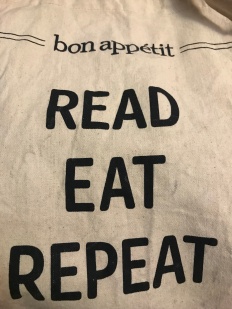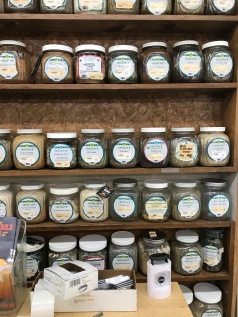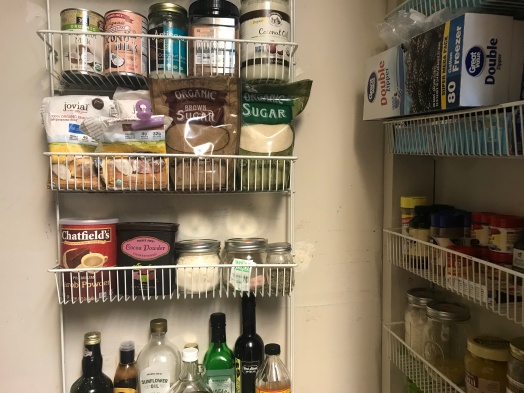This weekend I’ll be updating the tab on my website that highlights where you CAN shop in Baton Rouge if you’re going to dedicate yourself to a zero-waste life, or make steps toward that.
But, for today, I’m simply going to tell you what I do!
1. CANVAS BAGS
I have grown to love canvas bags so much, that now I use one as my purse, I use one as my lunch box and I use them as my grocery bags. They are practical, reusable and washable. What more could you want? Water-resistance? Yeah, working on that one…

In the case that I forget a bag (which hasn’t happened in a while because I keep some in my car, I keep one rolled up in my “purse” and I have a bunch at my house. But, if I forget, I will carry the stuff in my hands. I once walked out of TJ Maxx with arms full balancing a glass french press because there is no way in heck I’m taking a plastic bag.
2. BULK SECTION
I have come to love and appreciate buying in bulk. It is typically cheaper, and you start paying attention to how much you’re buying (which helps reduce food waste). Whole Foods in Town Centre has become my go-to bulk buying place because I can buy rice, beans, chick peas, flour, sugar, plantain chips, coconut flour, corn starch, lentils, nuts, chocolate covered raisins and seeds. It’s almost everything I need (though they stopped selling arrowroot powder and coconut sugar in bulk). I can also buy peanut butter in my jars.
To do this, you have to go to the customer service desk FIRST and weigh your jars and they will record the tare weight. Then, you fill up your jars and RECORD THE PLU #. I like to do so in my phone. I bring them to the cashier and I say, “oh that’s plantain chips, 5505.” My goal is to make the cashier’s interaction with me as stress-free as possibly possible. Therefore, I make sure I’m nice, I ask them how they’re doing (and listen for the answer) and I beat them to the punch with the Plu #’s so they’re not wasting their time.
3. GLASS / REUSABLE CONTAINERS
What I can’t buy in bulk, I try to find in glass or reusable containers. I buy a lot in bulk and I make my own granola and now coconut yogurt, that can all fit in the jars so I know I will use them. I buy broth, tapenade, pickles/olives, and salad dressing in glass jars.
4. RECYCLABLES / COMPOSTABLES
If I can’t find pasta, for example, in the bulk section, I will buy it in a cardboard box so that I can recycle it. I also like to look for compostable materials.
5. LOOSE VEGGIES AND FRUITS
I am mostly buying from Southside Produce (the only place I’ve found loose brussels). I will occasionally buy produce from Trader Joes and Whole Foods. I never use plastic bags for my veggies. I just toss them in my cart, or in a canvas bag. I do have draw string bags in an array of sizes and also an eco-bag for things like loose spinach or brussels sprouts. I don’t buy berries any more because they only come in plastic. But, when the farmers market is back and they’re in season, I will again.
6. MEAT???
A lot of zero-wasters are vegan or vegetarian and it is true that a plant-based diet is the most helpful and positive for the environment. I am currently reducing my meat intake MASSIVELY and I have committed to exclusively purchasing meat from Iverstine’s in Baton Rouge. Iverstine’s is a local butcher that has their own farm. I bring my own containers and grab whatever they have non-packaged. They have offered me any cut I want package free, if I call ahead, but I haven’t taken them up on it yet. If I feel like I need chicken (I have only bought once), I will buy an entire chicken. It comes from the farm in plastic, but that is the only plastic it has touched in its’ life (or death, RIP chicken). But, this is the most humane way to purchase chicken and it connects me to a living thing.
Buying meat from a local farm is the only sustainable way to buy meat. You can confirm what the animals are fed and how they are treated and you’re not placing money into mass corporations that are stuffing your food with harmful chemicals and mistreating animals for mass production. It’s also better for the environment to support local farms/butchers. Iverstine’s has been incredibly helpful and kind, easily the best package free option for meat.
7. HONEY / MAPLE SYRUP
I could buy honey from Whole Foods in a jar. However, bees are very important to the earth and we should always do a lot of research about where our honey comes from and how it is farmed. Therefore, I only buy local honey (sometimes from Fullness Farms, or Southside Produce has a lot of local options) or I get it from a friend.
Maple syrup: I buy in glass.
8. EGGS / CHEESE / MILK
These are the tricky ones. My eggs are expensive but worth it because of how the chickens are raised. They come in a recyclable or compostable container from Vital Farms. Can be purchased at Whole Foods or Our Daily Bread.
Cheese — I don’t buy cheese very much anymore but when I do, I get it package free from Whole Foods. Bring a clean tupperware with a lid, and you have to catch them when they’re cutting it at the Cheese section. Looking forward to trying a non dairy cheese, recipe from The Nutritious Table.
Milk — Oh, boy. This one is tough; I have yet to find milk in a glass container here in Baton Rouge. I’ve been buying coconut milk in recyclable cans lately. But, when I buy milk I buy an organic, grass fed, non-homogenized milk but it comes in plastic.

9. SPICES / OILS
I have bought bulk spices from Our Daily Bread, Whole Foods and Red Stick Spice Co.
I will buy coconut oil in a glass jar (I have bought from world market, trader joes, whole foods, etc). I have bought avocado oil from Trader Joes. I buy olive oil from Red Stick Spice Co. and they give a 20% discount for the refills ($14.95 instead of almost $19).
I have bought herbs as plants or loose. I will not buy them in plastic little containers.

I’ll post a “what’s in my pantry” soon, where I will go into the specifics of what I buy and why. When I shop, I’m trying to avoid plastic. My go-to is loose, bulk, then compostable, then recyclable. The goal when I shop is to avoid single-use items as best I can.
I have learned not to shop when I’m in a rush, but to take my time and go slow. I only grocery shop now when I know I have time to leisurely mosey around and think strategically about what I’ll eat for the week. I shop at least once a week and buy less so that I produce less food waste.
Zero-waste living isn’t fast-paced because convenience always comes at a cost.
I hope this helps you on your journey to reduce your waste and care for the earth, it is the only one we have.
One thought on “Grocery Shopping: How I shop”